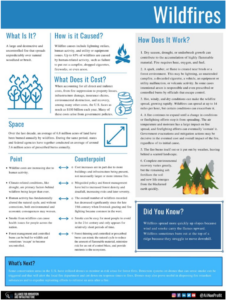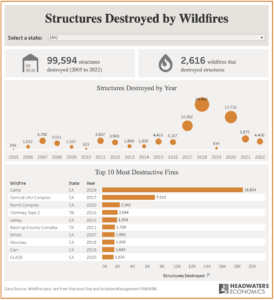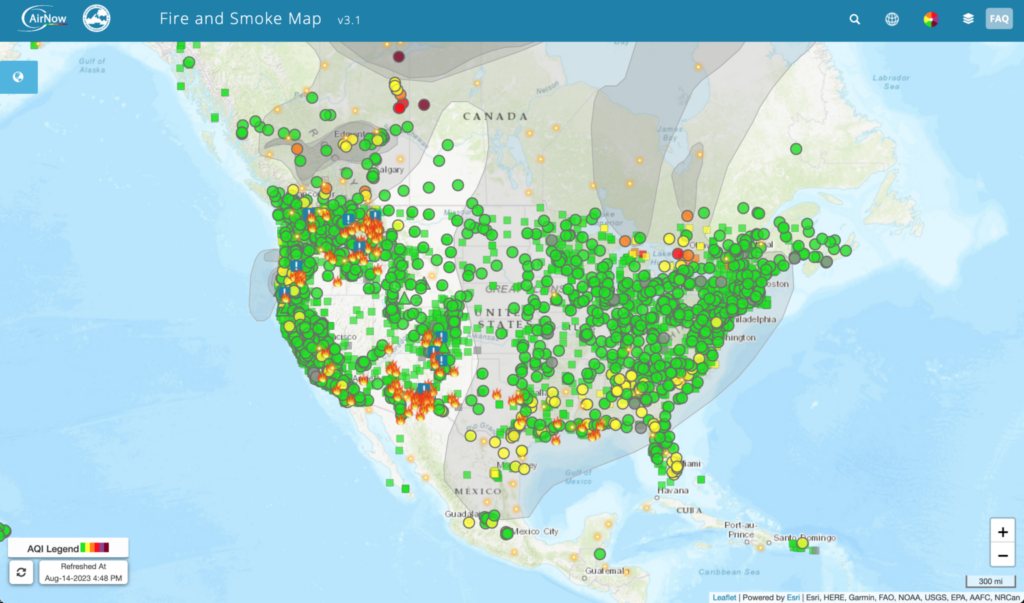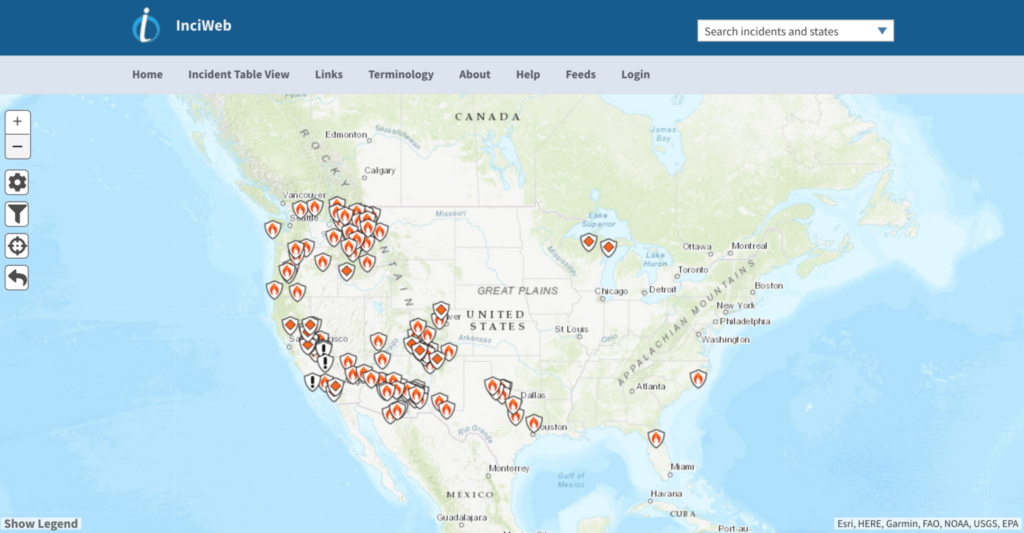Introduction
Wildfires have been burning on Earth for millennia. These are uninhibited fires that burn in forests, grasslands, and other environments rich with vegetation. Both human and natural causes, such as lightning strikes, can start wildfires, with the oldest charcoal fossil dating back to the Late Silurian era of around 420 million years. However, about 89 percent of wildfires in the U.S. are caused by humans. These causes can include leaving campfires unattended, improperly discarding cigarettes, burning of debris, and more.
The frequency of wildfires has been an important discussion over the past few decades. It is often measured in two ways: number of wildfires or area burned. Data for wildfire frequency in the U.S. and Canada from the last 20 years is shown below, each including a linear trend line.

Note: North Carolina is not included in data from 2004 Source: https://www.nifc.gov/fire-information/statistics/wildfires

Note: Data for 2023 is incomplete Source: https://ciffc.net/statistics
While the annual number of wildfires in the U.S have stayed fairly consistent and have even decreased in Canada, both countries have experienced an increasing amount of total area burned. This is commonly attributed to climate change: summers are getting longer and hotter while many areas are experiencing more droughts. As a result, there is likely greater volume of dry vegetation that serves as fuel for fires. In the U.S., fires are most common in the Western states with California leading in both number of fires and total acres burned. You can use the map below to see all currently active wildfires in the U.S. and Canada.
Click on the image above or here to interact with the data in a new tab.
Why It Matters
Wildfires can cause harm in a multitude of ways. This can include economic losses, damage to the environment, and risks to human health.
Economic Impact
Wildfires are costly for the economy in many ways – destruction of timber, property damage, suppression costs, and more.
Logging Industry
Wildfires also impact the logging industry by destroying lumber, damaging soil, and impacting other infrastructure. An Oregon study found that Oregon’s Forest Sector incurred losses of about $5.9 billion from destruction of timber, losses to contractors, road reconstruction costs and more. Additionally, it is predicted that the fires will cost between 1,200 and 3,000 jobs in the next 40 years as a result of 17 wildfires in 2020. Similarly, Florida’s St. John’s River Water Management District fires in 1998 burned almost 500,000 acres and timber losses costed an estimated $605 million.
Property Damage
Wildfires can also cause damage to property. In most cases , property is set ablaze from embers (burning pieces of vegetation) traveling through the air landing near structures, igniting vegetation or other debris in the area. In the past five years, wildfires have destroyed an estimated $22 billion worth of property in the United States. This includes $18.7 billion in damages to California alone, far surpassing any other state. From 2019 to 2022 , over 27,000 structures were burned with around 54 percent being residential property. Below, annual structures destroyed by wildfires from 2005 to June 2022 is shown along with total structures destroyed by state over the same time period.
The destruction of property by wildfires can impact the economy in multiple ways, such as affecting the housing market. A 2009 study in Southern California found that housing prices were down 10 percent after a first fire and 23 percent after a second. Homes destroyed by wildfires also have a significant effect on insurers, with over $20 billion in losses to California home insurers in just 2017 and 2018. This cost them is around twice their total profits over the previous 26 years. Residential property continues to be at risk to wildfires, with over 1.9 million homes at an elevated risk in the 15 most wildfire-prone states.
Suppression and Recovery Costs
With every wildfire, resources must be used to control and extinguish it. This is done by using water or fire retardant, spread by pumps, wildfire fire engines, helicopters, or airplanes, and removing the fire’s fuel by clearing areas of vegetation with heavy equipment. These efforts are very costly, with almost $15 billion spent on wildfire suppression in the U.S. in the past 5 years. The chart on the right shows annual spending on wildfire suppression by the Forest Service and Department of the Interior Agencies since 1985.
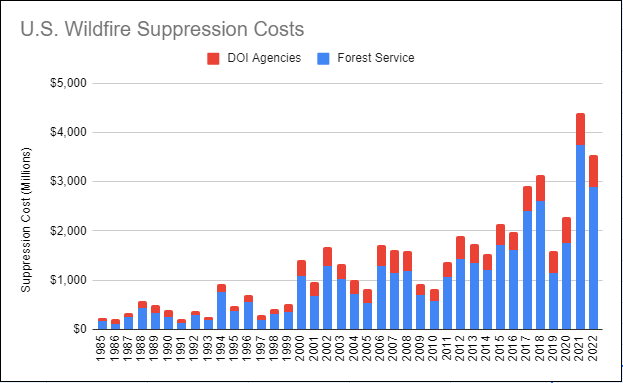
The federal government also provides disaster relief to areas effected by wildfires through the Federal Emergency Management Agency (FEMA) by giving financial assistance to state and local governments, people, and businesses that have been negatively impacted by disasters. From 2016 to 2020, FEMA spent about $5 billion in assistance for fire-related disasters. Additionally, the Forest Service and DOI also work to rehabilitate federal lands affected by wildfires. Funds can be accessed if the federal government issues a fire management assistance declarations, emergency declarations, or major disaster declarations. State and local governments can receive aid under all three declarations while individuals and businesses can only receive aid under emergency or major disaster declarations. These declarations are only issued when wildfire damages exceeds the ability of state and local governments to respond. From 2016 to 2020, 4 wildfires were designated an emergency declaration and 9 were designated a major disaster declaration.
Environmental Impact
Wildfires can also have a major effect on the environment, including releasing greenhouse gases and impacting ecosystems.
Greenhouse Gases
Wildfires are known to emit greenhouses gases, most notably carbon dioxide. In 2021, boreal forest fires in North America and Eurasia released around 1.76 billion tons of CO 2 . To put this in perspective, it is about double the amount of CO 2 that was emitted from global air travel in the same year. More recently, as of late June, this year’s Canadian wildfires have the greatest annual emissions of any in the country of the past 21 years of data analyzed, according to the Copernicus Atmosphere Monitoring Service. Increasing greenhouse gases in our atmosphere continues to be problematic for the environment by exacerbating the greenhouse effect and causing global temperatures to rise.
Ecosystems
Because wildfires have been around for millions of years, many ecosystems are not harmed by their presence. Many that are prone to wildfires have mostly adapted to phenomenon and can even benefit from it. The fire can cause in increase in the availability and nutrient content of forage and browse that wildlife consume. Many ecosystems also have the ability to recover from wildfires with newly enriched soils aiding in the growth of new vegetation. However, high severity burns can have more harmful effects such as damaging soil. These effects are getting worse, as wildfire sites with no regrowth has almost doubled since 2000 , an increase from 19 percent to 32 percent. Severe fires in Colorado in 2020 also demonstrated an effect on wildlife as large populations of migratory birds were destroyed as a result . Additionally, wildfires in areas that don’t often experience them historically are impacted much more severely as these ecosystems have not adapted to such conditions.
Human Health Risks
Wildfires can impact human health in a variety of ways, including damage to air and water quality. These effects not only impact humans but also wildlife.
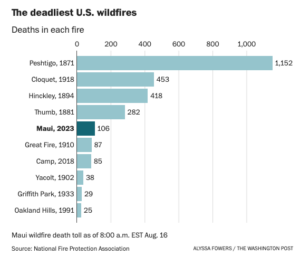
Air Quality
Aside from carbon dioxide emissions, wildfires release many pollutants that are harmful to human health, including nitrogen dioxide, aromatic hydrocarbons, lead, and particulate matter, also known as PM 2.5 . Many of these pollutants are small enough to enter our respiratory system unfiltered and be lodged in the lungs. These particles can cause coughing, trigger asthma attacks, and increase risk of cancer.
In 2023, the Canadian wildfires have led to poor air quality in many areas. In the US, over 100 million people were under alerts for unhealthy air quality on June 7, with smoke being visible in many major cities in the country. In some cities, such as Chicago and Washington D.C., there was even a purple air quality alert, meaning the air quality is very unhealthy and can impact the average person. As a result, people are recommended to wear N95 face masks to protect themselves from inhaling dangerous particles. Below is a map that displays current air quality levels along with burning fires.
Click on the above map or here to interact with the data in a new tab.
Water Quality
Wildfires also have a significant effect on water quality. After a fire, soil in the area has difficulty absorbing moisture, resulting in watersheds retaining greater amounts of nitrogen and carbon dioxide up to 15 years after a fire. This is problematic, as about half of the water supply in the Southwest originates from forests, with 3,400 public drinking water systems being located in national forests across the country. Wildfires can also release dissolved organic matter that can be problematic for water treatment and increase costs . Additionally, wildfires can burn man-made structures composed of plastic, such as service lines. These burned or melted plastics can end up in drinking water and pose risks to human health.
Prevention and Mitigation
While some amount of wildfires are healthy for the planet and occur from natural causes, preventing more and larger wildfires is important for all of the reasons mentioned above. Better forest management is key to preventing wildfires, including prescribed burns, better tree thinning and spacing, and more. Additionally, educating the public on best practices for preventing wildfires can go a long way in reducing human caused fires. When it comes to mitigation, improved wildfire detection along with more home hardening, better evacuation routes, and improved air filtration can reduce the impact wildfires have on communities.
Forest Management
A large reason wildfires are becoming larger, if not more numerous, is because of poor forest management. For much of the 20th century, firefighters worked to put out all of the wildfires across the United States, but wildfires are a part of the natural cycle of forests. By putting out every fire, the forests have become ‘choked’ with deadfall that was normally burned away by low intensity wildfires. By focusing on fire suppression instead of fire prevention, firefighters have inadvertently added fuel that makes fires grow larger and more intense.
Better forest management is needed to prevent wildfires from becoming worse. Forest management includes careful clearing of deadfall, using controlled burns, and thinning the amount of available fuel for a fire.
Controlled Burns
Controlled burns, also known as prescribed fires, is the use of fire by specialists to burn vegetation that is fuel for wildfires. These fires are low severity and administered under specific weather conditions to ensure that they are adequately controlled. The map below shows active wildfires along with current prescribed fires.
Click on the above map or here to interact with the data in a new tab.
This tool is one of the most effective in managing wildfires and reducing their harmful consequences. In fact, a 2023 study predicts that controlled burns in the 2020 fire season could have reduced the population-weighted smoke exposure by 21 micrograms per cubic meter of air in the West. However, from 2015 to 2020, northern California and western Oregon only conducted seven controlled burns despite the fact that they are disproportionately impacted by smoke exposure from wildfires. The main obstacles preventing the use of prescribed fires include poor weather conditions, personnel availability, negative public perception and lack of money, as a controlled burn can cost between $100 and $1,000 per acre. If we are to increase the use of this tool, more funds and raising public awareness are integral.
Tree Thinning and Spacing
Tree thinning and tree spacing aim to lower the density of forests in order to prevent and mitigate wildfires. Tree thinning is the practice of removing trees, often dead or diseased, in forests to create space between vegetation. Tree spacing is the practice of planting trees further apart for similar reasons. Reducing forest density is important as more dense forests have greater amounts of fuel for fire and will spread fire more easily even at low wind strengths. Tree thinning can be a good alternative to prescribed fires in the short term, as reported in this 2021 study, finding: “Thinning without prescribed fire significantly reduced potential crown fire immediately following thinning and also moderated surface modeled fire behavior beginning 2–3 years following thinning.” However, similar to controlled burns, one of the main challenges for forest thinning are high costs, ranging from $16.44 to 41.87 per metric ton. However, new technologies can drive down costs as they are adopted.
Detection
A critical part of wildfire mitigation is being able to detect them so firefighting services can control the fire. Common methods of detection include reports from the general public, air patrols, lookout stations, and sensors. There are also some more technologically advanced ways to detect wildfires, such as tools NASA uses from space. They use two different kinds of satellites to monitor wildfires: polar orbiters and geostationary platforms. Polar orbiters take global images that show smoke on the planet’s surface in detail up to two times a day. Geostationary platforms remain at a fixed point above the equator and take pictures of a portion of the earth’s surface every five minutes. In addition to satellites, NASA uses other instruments from space such as ASTER, which can monitor temporal change on the earth’s surface.
In addition to off-planet technologies, artificial intelligence is now being used to detect wildfires. Wildfire security systems consist of multiple high definition cameras monitored by AI that can identify signals of smoke. The AI will sound an alert that can be reviewed by humans and also triangulate the location of a fire. This technology is critical to increasing the efficiency of responding to wildfires as only one in 20 emergency calls reporting wildfires are true. Instead of personnel being dispatch to investigate all reports, AI can verify their accuracy, saving time and resources. Artificial Intelligence is already being used for wildfire detection in many states, including California and Arizona, with companies such as Pano pioneering multi-million dollar projects with the technology. Embracing innovation in the area is integral to reducing the severity of wildfires and the damage they cause.
Home Hardening
Part of wildfire mitigation is reducing structure’s ability to spread fire and decreasing the damage done to them. Home hardening does this by modifying houses and other structures in fire-prone areas to be better protected from wildfire. This starts with the areas around the structure by clearing it of combustible materials that can be ignited by embers and spread fire to the home. Fitting a structure with a fire resistant roof, with materials such as metal, clay, and tile, along with fire-resistant walls and siding aid in protecting buildings from wildfires. Additionally, embers can enter the home through vents so using 1/16 to 1/8 inch metal vent covers is an important measure. There are many other home hardening practices to protect structures from wildfires. You can learn more here.
Home hardening is an important tool for increasing the resilience of communities prone to wildfires. The map below shows which areas can benefit the most from increased use of this method.
Evacuation Routes
Keeping people safe from wildfires is another integral part of mitigation. Many states and counties prone to wildfires have planned evacuation routes in case of emergency. For example, this website provides maps of evacuation routes for every area in Marin County, CA for residents. If you live in an area high at risk for wildfires be sure to have an evacuation plan for such an event.
Improving evacuation plans is key. Using traffic and population data to find more better routes that can move people more efficiently can aid in speeding up evacuation and improve public safety. The map below estimates where better evacuation routes will provide the most benefit to communities.
Air Filtration
Reducing the impact of wildfire smoke on human populations is another important part of mitigation. This can be done with home air filtration systems that keep residents safe from harmful smoke and air particles. Improved air filtration comes in many forms, including air purifiers, upgraded HVAC filters, and other DIY solutions recommended by the EPA. The map below shows where improving access to air filtration systems will help with wildfire resilience.
Moving Forward
As we continue to see and feel the impacts of wildfires on the continent, it is integral to keep in mind why and how often they are occurring, how they affect people and the environment, and the many tools and strategies available to combatting them. From prevention tactics such as forest management to mitigation strategies including home hardening, there are many investments we can make for keeping us and our neighbors safe. Furthermore, research and innovation has changed the way we detect and get ahead of dangerous fires. Reducing the costs of these measures continues to be important for improving our response to wildfires. As we move forward, it is necessary to continue thinking about best policy and practices for wildfire prevention and mitigation in addition to attacking the root causes of the issue.
